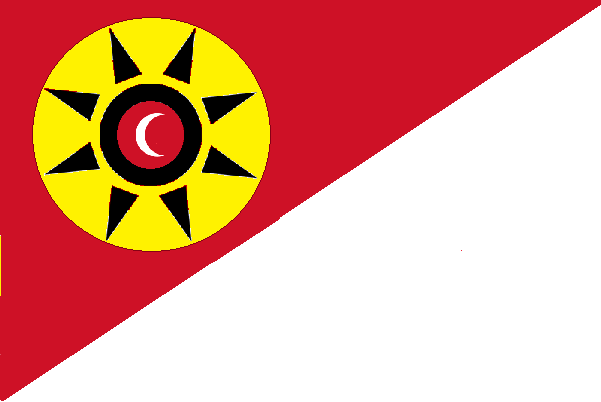BY LETTER
Indonesia
History > 0030 to 0900 AT: Solsys Era > 130 to 400 AT: The Interplanetary Age
History > 0030 to 0900 AT: Solsys Era > 400 to 530 AT: The Solsys Golden Age
History > 0030 to 0900 AT: Solsys Era > 530 to 900 AT: The Sundering
Galactography > Historical Polities
Galactography > Places and Locales
History > 0030 to 0900 AT: Solsys Era > 400 to 530 AT: The Solsys Golden Age
History > 0030 to 0900 AT: Solsys Era > 530 to 900 AT: The Sundering
Galactography > Historical Polities
Galactography > Places and Locales
 Image from MacGregor | |
| Flag of the Corporate Republic of Indonesia | |
Indonesia is a large archipelago on Old Earth in South-East Asia and a former nation-state lasting from the Industrial Age to the Great Expulsion.
First settled by humans around 45,000 BT, Indonesia became dominated by various Austronesian peoples eventually forming groups such as the Javanese, Sundanese, Balinese, and many others. Situated as it was on the peripheries of the Chinese and Indian spheres of influence, Indonesia developed a unique blend of South, South East, and East Asian cultures. The arrival of Muslim traders had a profound effect on the islands with the vast majority of inhabitants eventually converting, mixing Islam with previous Buddhist, Hindu, and animist practices. By the 2nd century BT, the archipelago fell under the control of the Dutch, a mercantile Christian people from Europe. The Dutch and other colonizers sought out valuable trade goods such as spices, coffee, timber, and later petroleum and rubber. After the World Wars of the 1st century BT, most of the archipelago achieved its independence as the Republic of Indonesia led by Koesno Sosrodihardjo, known to history as Sukarno.
The first two centuries of independence often proved a difficult time for Indonesia, as the new nation struggled with poverty, political instability, and the effects of climate change. In 131 AT, the country adopted a new constitution styling itself as the Corporate Republic of Indonesia. The "Corporate" moniker referred to the polity's concentration on group instead of individualist identity and is not an indicator of corporatocracy as is sometimes thought. Over the next several decades, Indonesia made a series of sweeping political and economic reforms that started its long ascent, becoming a world power by the end of the century. During this time, Indonesia saw the waning of Islamic influence and inroads made by various irreligious movements, Christianity, and to a lesser extent Neo-Kejawèn. In 196 AT, Indonesia began construction of the globe's first space elevator, the Tangga Bintang ("Ladder to the Stars") on the island of Sulawesi. With preferential access to the space elevator, Indonesians embarked on an impressive bout of space colonization and development. Notable settlements included Sisi Gelap ("Darkside") in Luna's Planck Crater, Kota Merah ("Red City") on Mars, and the Sultan Agung, a roving city-ship that travelled the volume between Venus and Jupiter during the half century before the Technocalypse. Indonesia was also involved in the colonization of Pi3 Orionis.
Strict adherence to the Treaty Org during the Last War proved costly for Indonesia, much of which was already devastated by the plagues of the Technocalypse. After the Great Expulsion, Indonesians established several habitats in what became the Bracelet Band and other points in the outer solar system. The government in exile was officially disbanded in 651 AT by Council-President Ketut Tri Slamet Batari, an emancipated biont synthetic human. In the current era, GAIA has returned the archipelago to its pre-industrial state, except for the Tangga Bintang. The ongoing ice age has lowered sea levels, connecting many areas that were once disparate islands. One detects traces of Indonesia's influence on the Terragen Sphere in the names of various places such as the planet New Java, Palembang City in the Stella Umma, the Sukarno continent on Daedalus I, Jakarta Station in Beta Virginis, and a number of locations on worlds in Solsys. Sadly for many modosphonts, the best known connection to Indonesian history today is the ahuman S3 entity and possible blight Dewata Cengkar. The sobriquet is a reference to a giant demon king from ancient Javanese mythology, although the reason for eir choosing this title is unknown.
Related Articles
Appears in Topics
| 130 to 400 AT: The Interplanetary Age | 400 to 530 AT: The Solsys Golden Age | 530 to 900 AT: The Sundering |
| Historical Polities | Places and Locales |
Development Notes
Text by MacGregor
From an original by M. Alan Kazlev; rewritten by MacGregor 21 July 2018
Initially published on 10 November 2001.
From an original by M. Alan Kazlev; rewritten by MacGregor 21 July 2018
Initially published on 10 November 2001.






